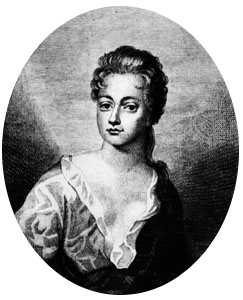User:Bishonen/Bracegirdle

Anne Bracegirdle (1663–1748) was an English actress. She was probably raised by the actors Thomas and Mary Betterton from an early age, and it is speculated that she was the "little girl" referred to several times in playbills before 1688 for the Duke's Company, where Thomas Betterton was the big star. Her name first appears in the Lord Chamberlain's accounts in 1688 as a member of the United Company (into which the Duke's Company had by then merged), and a few of her roles in the following years are known through surviving manuscript cast lists. She played Semernia in Aphra Behn's The Widow Ranter in 1689, a breeches role, which was a type of role she would often return to, and was by 1690 playing parts like Lady Anne in Shakespeare's Richard III and Desdemona in Othello. In a very few years, she had become one of the important members of the company and an audience favorite, as is indicated by the frequency with which she spoke prologues and epilogues.
Colley Cibber described Bracegirdle in his autobiography as she appeared in 1690, when he first joined the company at Drury Lane:
- "She had no greater Claim to Beauty than what the most desirable Brunette might pretend to. But her Youth and lively Aspect threw out such a Glow of Health and Chearfulness, that on the Stage few Spectators that were not past it could behold her without Desire. It was even a Fashion among the Gay and Young to have a Taste or Tendre for Mrs. Bracegirdle… In all the chief Parts she acted, the Desirable was so predominant, that no Judge could be cold enough to consider from what other particular Excellence she became delightful".
Cibber was smitten: he describes his own highest ambition as a new and inconspicuous company employee, never fulfilled, to have been that of "playing a Lover with Mrs. Bracegirdle". In 1692, the "tendre" which both Captain Richard Hill and the actor William Mountfort had for her caused a celebrated tragedy, whereby the jealous Hill and a gang of toughs, led by the infamous Lord Mohun, first attempted to abduct Anne, and then murdered Mountfort, her presumed successful lover, in the street. Hill made his escape from justice, but Mohun stood trial and was acquitted; both died violent deaths some years later.
By 1694, Bracegirdle's skill as a high comedienne was fully developed and recognized, and William Congreve and others were writing roles especially for her. She frequently played the comedienne part of a tragic/comic heroine tandem together with the tragedienne Elizabeth Barry, offsetting Barry's passively suffering heroines with vivacious breeches-wearing guardian-tricking girls of great initiative, to bring audiences the typical Restoration drama tragic/comic rollercoaster experience (see Howe).
In 1695, the monopoly United Company was torn apart by actor/management conflict, and the disgruntled senior actors led by Betterton, Barry, and Bracegirdle left to form their own collaborative company. Bracegirdle was one of the original patent-holders of the actors' company, and she played Angelica when it opened with the première of Congreve's Love For Love, the greatest hit of the 1690s. Congreve had tailored Angelica especially to Bracegirdle's talents and stage presence, as he also did five years later with one of the most famous women's roles in British theatrical history, Millamant in The Way of the World (1700).
In contrast to Betterton and Barry, Bracegirdle quitted the stage early, in 1706. She was discreet in her private life, but rumor inevitably coupled her name with Congreve's. Congreve left her a legacy when he died in 1729.
References[edit]
- Howe, Elizabeth (1992). The First English Actresses: Women and Drama 1660–1700. Cambridge: Cambridge University Press.
- Cibber, Colley (first published 1740, ed. Robert Lowe, 1889). An Apology for the Life of Colley Cibber, vol.1, vol 2. London.
- Highfill, Philip Jr, Burnim, Kalman A., and Langhans, Edward (1973–93). Biographical Dictionary of Actors, Actresses, Musicians, Dancers, Managers and Other Stage Personnel in London, 1660–1800. 16 volumes. Carbondale, Illinois: Southern Illinois University Press.
